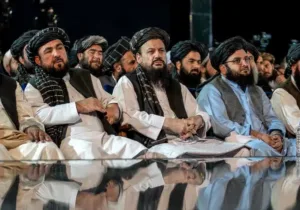The strategically ill-considered, operationally inept yet tactically brutal Russian invasion of Ukraine reveals several emerging trends that will resurface in future global conflicts. As a result and at the risk of inadvertently drawing conclusions warranting further data, we can see at least six broad trajectories deserving consideration.
Mission Command — The United States Army’s operational doctrine codifies mission command as a method of decentralized tactical decision-making predicated on a clear commander’s intent, assumption of risk, subordinate leader initiative, robust unit training, and sufficient resourcing for mission accomplishment. While not an exact match to how the forces of Ukraine have bravely fought the Russians to a halt, their forces have clearly employed a similar effort at exercising command and control in the close fight. Contrasted to the sclerotic, headquarters-based decision-making of Russian regular and guard forces and their land force model without effective non-commissioned officers, it’s no wonder that Ukrainian forces (trained prior to the war by experts of multiple Western militaries) have pivoted so well at changing conditions on the ground. Tactical flexibility and empowered subordinate initiative are proving to be keys to victory.
Population Centers — Russian forces have, with complete disregard for any predicate of non-combatant immunity, repeatedly focused their attacks on major population centers. Utilizing both direct and indirect fire systems—including infantry, special operations forces, armor, artillery, attack aviation, and missiles—the invaders focused their efforts at isolating or capturing key targets such as Kyiv, Kharkiv, Mariupol, and Odesa. Certainly, this was designed to create refugee crises and perhaps pursue a strategy of defeating in detail Ukrainian forces spread too thin and trying to defend multiple cities at once. Nonetheless, Russian forces have followed their pre-war asymmetric doctrine of focusing their operational efforts on major cities. Many factors have precluded Russia from succeeding in this effort—including the tactical agility of Ukrainian forces, their advantage of defending known ground and homes, and the manifest bravery of their warriors—but the risk has been high. Should Ukrainian national will falter or even one of these key centers finally fall, such as Mariupol, then Russian doctrine may prove both operationally and strategically successful, particularly in the southeast.
Speed of Decision-making — A major proposition of all-domain operations (the US joint force operational doctrine encompassing simultaneous warfare through and across land, sea, air, space, and cyberspace) is that decision-making will necessarily not only be de-centralized but also be rapidly increased. Indeed, contemporary strategic experts have forecast that commander decisions in future wars will be reduced from hours or even minutes to seconds, particularly through automated, pre-programmed software in weapons platforms and munitions. The war in Ukraine bears out this trend. With Russian forces initially bogged down by the afore-mentioned adherence to rigid plans, centralized decision-making, and a lack of leader initiative, Ukrainian forces have successfully countered with a rapid assessment of emerging tactical developments paired with fast decision-making designed to imperil Russian invaders, with great effect. In essence, the lesson here is that both mission command and speed of decision-making, used in tandem, can greatly increase tactical and operational lethality.
Artificial Intelligence — This area of emerging technology is defining along trajectories of machine learning, brain computer interfacing, and use of lethal autonomous weapons systems (LAWS). While Ukraine has not completely utilized LAWS as defined, they have used to devastating effect semi-autonomous weapons systems, particularly unmanned aerial systems (UAS), more commonly known as drones. The Nagorno-Karabakh Conflict of 2020 demonstrated on Russian-backed Armenian forces just how effective these systems could be, as Turkish-backed Azerbaijani forces used UAS for precision targeting of artillery. The Azerbaijanis would fly a drone over Armenian formations, develop target reference points within meters, and then either use air-to-ground UAS missiles or artillery to destroy Armenian forces before they could ever enter battle. The Ukrainians learned this tactic well and, armed with similar systems either purchased commercially or provided by supporting militaries, have made Russian massed formations pay a similar price.
Intelligence Sharing — It is clear through open source reporting that Western intelligence sharing with Ukrainian forces has proven decisive at key junctures of this war. Particularly relying on data shared from both the United States and Great Britain about Russian operational movements from compromised Russian communications patterns and methods, the Ukrainians have been able to place their limited direct and indirect fire systems at key points on the battlefield. Besides the United States’ strategic decision to publicly reveal Russian invasion plans and times in the first place—a type of information operation in and of itself—the Ukrainians were able to utilize key intelligence to repel the early Russian airborne operations to seize the airport at Hostomel outside Kyiv and retain this vital transportation hub. Clearly, this tactic remains ongoing. But so frustrated have the Russians become as a result that their forces have resorted to communicating over commercial systems “in the clear,” and so even more imperil their tactical planning.
Strategic Moral and Spiritual Injury — A final trend is sadly evident. With the aforementioned Russian targeting of population centers aimed at breaking Ukrainian national will, there is an immense moral and spiritual cost to this war being borne by the nation’s non-combatant citizens. Tough, resilient, and determined not to yield, nonetheless Ukrainian citizens are suffering from the effects of this deliberate Russian targeting of civilians in combat and use of the evil tactic of mass murder, as evidenced by graves now being uncovered in places like Bucha. As well, the Russians have also engaged in a deception of offering safe passage to Ukrainian citizens out of engagement areas only to forcibly remove them to inside Russia, a fate which President Volodymyr Zelensky recently estimates has befallen over 500,000 Ukrainians. Such brutality will exact a toll on individual Ukrainians, their families, and communities now and for decades, exacerbating the effect of strategic moral and spiritual injury long after this war ceases. Still, the moral, ethical, and religious resilience of the Ukrainian people is holding its own and proving a critical factor in their continued successful repulsion of Russian aggression.
In sum, the war in Ukraine is proving to be a tragic proving ground for trends that will almost certainly be replicated in other twenty-first-century warfare. Decentralized decision-making, the targeting of population centers, tactical speed in decision-making, the rise of artificial intelligence, vital intelligence sharing, and the strategic impact of moral and spiritual injury demonstrate the boundaries for future combat. Other factors in the tactical fight not mentioned here, such as ammunition and weapon resupply, medical infrastructure and casualty evacuation, refugee movement, and others will also mark future wars. However, astute military and national security professionals and citizens would do well to internalize these six emerging trends. Given the renewal of great power conflict and the risk of such war surfacing outside Ukraine, wisdom and prudence demand all peoples study this war to best prepare, as the future is becoming tragically clear.
The views expressed herein are those of the author and do not necessarily reflect the official policy or position of the Department of the Army, Department of Defense, or the US Government. They are provided solely to advance academic and public discourse on the topics addressed.






